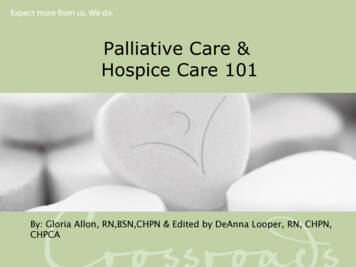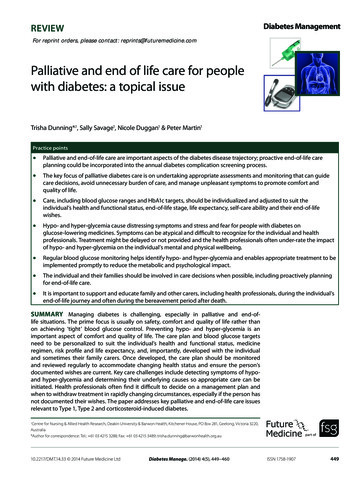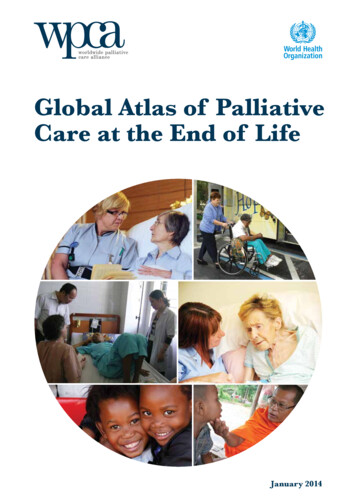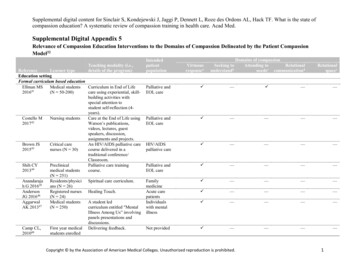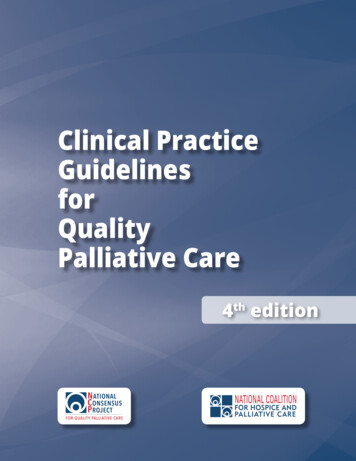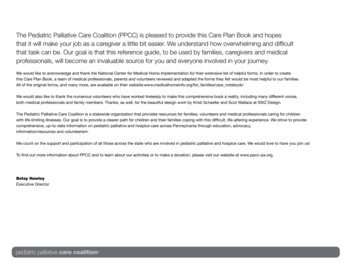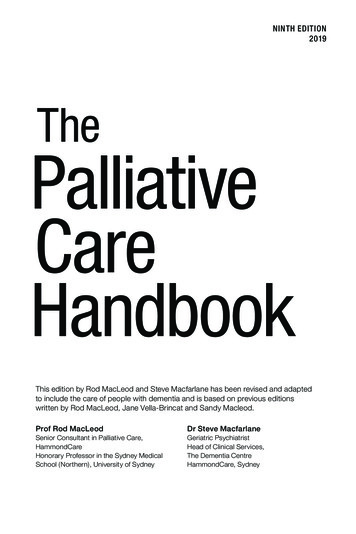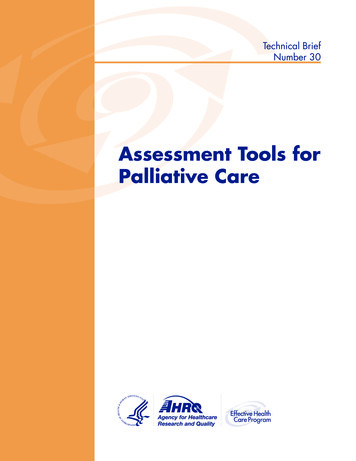
Transcription
Technical BriefNumber 30Assessment Tools forPalliative Caree
Technical BriefNumber 30Assessment Tools for Palliative CarePrepared for:Agency for Healthcare Research and QualityU.S. Department of Health and Human Services5600 Fishers LaneRockville, MD 20857www.ahrq.govContract No. 290-2015-00006-IPrepared by:Johns Hopkins University Evidence-based Practice CenterBaltimore, MDInvestigators:Rebecca Aslakson, M.D., Ph.D.Sydney M. Dy, M.D., M.S.Renee F. Wilson, M.S.Julie M. Waldfogel, Pharm.D.Allen Zhang, B.S.Sarina R. Isenberg, M.A.Alex Blair, M.D.Joshua Sixon, B.S.Karen A. Robinson, Ph.D.AHRQ Publication No. No. 17-EHC007-EFMay 2017
This report is based on research conducted by the Johns Hopkins University Evidence-basedPractice Center (EPC) under contract to the Agency for Healthcare Research and Quality(AHRQ), Rockville, MD (Contract No. 290-2015-00006-I). The findings and conclusions in thisdocument are those of the authors, who are responsible for its contents; the findings andconclusions do not necessarily represent the views of AHRQ. Therefore, no statement in thisreport should be construed as an official position of AHRQ or of the U.S. Department of Healthand Human Services.None of the investigators have any affiliations or financial involvement that conflicts withthe material presented in this report.The information in this report is intended to help health care decisionmakers—patients andclinicians, health system leaders, and policymakers, among others—make well-informeddecisions and thereby improve the quality of health care services. This report is not intended tobe a substitute for the application of clinical judgment. Anyone who makes decisions concerningthe provision of clinical care should consider this report in the same way as any medicalreference and in conjunction with all other pertinent information, i.e., in the context of availableresources and circumstances presented by individual patients.This report is made available to the public under the terms of a licensing agreement between theauthor and the Agency for Healthcare Research and Quality. This report may be used andreprinted without permission except those copyrighted materials that are clearly noted in thereport. Further reproduction of those copyrighted materials is prohibited without the expresspermission of copyright holders.AHRQ or U.S. Department of Health and Human Services endorsement of any derivativeproducts that may be developed from this report, such as clinical practice guidelines, otherquality enhancement tools, or reimbursement or coverage policies, may not be stated or implied.Persons using assistive technology may not be able to fully access information in this report. Forassistance, contact EffectiveHealthCare@ahrq.hhs.gov.Suggested citation: Aslakson R, Dy SM, Wilson RF, Waldfogel JM, Zhang A, Isenberg SR,Blair A, Sixon J, Robinson KA. Assessment Tools for Palliative Care. Technical Brief No. 30(Prepared by Johns Hopkins University under Contract No. 290-2015-00006-I.) AHRQPublication No. 14-17-EHC007-EF. Rockville, MD: Agency for Healthcare Research andQuality; May 2017. .doi: https://doi.org/10.23970/AHRQEPCTB30.ii
PrefaceThe Agency for Healthcare Research and Quality (AHRQ), through its Evidence-basedPractice Centers (EPCs), sponsors the development of evidence reports and technologyassessments to assist public- and private-sector organizations in their efforts to improve thequality of health care in the United States. The reports and assessments provide organizationswith comprehensive, science-based information on common, costly medical conditions and newhealth care technologies and strategies. The EPCs systematically review the relevant scientificliterature on topics assigned to them by AHRQ and conduct additional analyses, whenappropriate, prior to developing their reports and assessments.This EPC evidence report is a Technical Brief. A Technical Brief is a rapid report, typicallyon an emerging medical technology, strategy, or intervention. It provides an overview of keyissues related to the intervention—for example, current indications, relevant patient populationsand subgroups of interest, outcomes measured, and contextual factors that may affect decisionsregarding the intervention. Although Technical Briefs generally focus on interventions for whichthere are limited published data and too few completed protocol-driven studies to supportdefinitive conclusions, the decision to request a Technical Brief is not solely based on theavailability of clinical studies. The goals of the Technical Brief are to provide an early objectivedescription of the state of the science, a potential framework for assessing the applications andimplications of the intervention, a summary of ongoing research, and information on futureresearch needs. In particular, through the Technical Brief, AHRQ hopes to gain insight on theappropriate conceptual framework and critical issues that will inform future research.AHRQ expects that the EPC evidence reports and technology assessments will informindividual health plans, providers, and purchasers, as well as the health care system as a whole,by providing important information to help improve health care quality.If you have comments on this Technical Brief, they may be sent by mail to the Task OrderOfficer named below at: Agency for Healthcare Research and Quality, 5600 Fishers Lane,Rockville, MD 20857, or by email to epc@ahrq.hhs.gov.Sharon B. Arnold, Ph.D.Acting DirectorAgency for Healthcare Research and QualityStephanie Chang M.D., M.P.H.DirectorEvidence-based Practice Center ProgramCenter for Evidence and PracticeImprovementAgency for Healthcare Research and QualityArlene S. Bierman M.D., M.S.DirectorCenter for Evidence and PracticeImprovementAgency for Healthcare Research and QualityDavid W. Niebuhr, M.D., M.P.H., M.S.Task Order OfficerCenter for Evidence and PracticeImprovementAgency for Healthcare Research and Qualityiii
AcknowledgmentsWe gratefully acknowledge the following individuals for their contributions to this project: DioKavalieratos, Ph.D., and Dara Ikejiani for their assistance with the section about evaluation ofinterventions; Jennifer Wolff, Ph.D., and Karl Lorenz, M.D., M.H.S., for their input on specificresults sections; and Jeanette Edelstein, M.A., for her copy editing service.Key InformantsIn designing the study questions, we consulted a panel of Key Informants that representedsubject experts and end-users of research. Key Informant input can inform key issues related tothe topic of the technical brief. Key Informants are not involved in the analysis of the evidencenor the writing of the report. Therefore, in the end, study questions, design, methodologicalapproaches, and/or conclusions do not necessarily represent the views of individual KeyInformants.Key Informants must disclose any financial conflicts of interest greater than 10,000 and anyother relevant business or professional conflicts of interest. Because of their role as end-users,individuals with potential conflicts may be retained. We worked with the Task Order Officer tobalance, manage, or mitigate any conflicts of interest.The list of Key Informants who provided input to this report follows:UW MedicineSeattle, WAKaren A. Armacost, M.S.A., R.N.*Caregiver AdvocateBaltimore, MDSteven Z. Pantilat, M.D.*University of California, San FranciscoSan Francisco, CAMarie Bakitas, D.N.Sc, C.R.N.P.*University of Alabama at BirminghamSchool of Nursing & Department ofMedicineBirmingham, ALHolly G. Prigerson, Ph.D.*Cornell UniversityWeill Cornell Medical CollegeNew York, NYDena BattleCaregiver AdvocateAlexandria, VAJoan Teno, M.D., M.S.*University of WashingtonSeattle, WAEduardo Bruera, M.D.*The University of TexasM.D. Anderson Cancer CenterHouston, TXJoanne Wolfe, M.D., M.P.H.*Dana Farber Cancer InstituteBoston, MAJ. Randall Curtis, M.D., M.P.H.*University of Washington*This Key Informant also provided review of the draft reportiv
Peer ReviewersPrior to publication of the final evidence report, we sought input from independent PeerReviewers without financial conflicts of interest. However, the conclusions and synthesis of thescientific literature presented in this report do not necessarily represent the views of individualreviewers.Peer Reviewers must disclose any financial conflicts of interest greater than 10,000 and anyother relevant business or professional conflicts of interest. Because of their unique clinical orcontent expertise, individuals with potential nonfinancial conflicts may be retained. We workedwith the Task Order Officer to balance, manage, or mitigate any potential nonfinancial conflictsof interest identified.The list of Peer Reviewers follows:Betty Ferrell, Ph.D., M.A, FAAN, FPCNCity of HopeDuarte, CAJean Kutner, M.D., M.S.P.H.University of Colorado School of MedicineAurora, COJeri L. Miller, Ph.D.NIH, National Institute of Nursing ResearchBethesda, MDJennifer Temel, M.D.Massachusetts General HospitalBoston, MADeborah Waldrop, Ph.D., M.S.W.University of BuffaloBuffalo, NYv
Assessment Tools for Palliative CareStructured AbstractObjectives. To (1) provide an overview of palliative care assessment tools designed to becompleted by or with patients or caregivers, including which tools have been applied to clinicalcare, as quality indicators, or in evaluations of interventions, and (2) identify needs for futurepalliative care assessment tool development and evaluation.Methods. First, we engaged Key Informants representing both patient/caregiver andprovider/researcher perspectives to help guide the project. We then sought systematic reviews ofpalliative care assessment tools and applications of tools through searches of PubMed, CINAHL,Cochrane, PsycINFO and PsycTESTS from January 1, 2007 to August 29, 2016. We conductedsupplemental searches of information on palliative care tools, including comprehensive reviewspublished prior to our date limitation, Web sites, and a targeted search for primary articles toidentify tools where no recent high-quality systematic review was identified. We organized toolsby the eight domains (subdomains) from the National Consensus Project Clinical PracticeGuidelines for Palliative Care: structure and process, physical, psychological and psychiatric,social (caregiver), spiritual and religious, cultural, care at the end of life (bereavement), ethicaland legal; as well as a ninth domain for multidimensional tools (quality of life and patientexperience).Results: We included 10 systematic reviews of palliative care assessment tools (7 addressingdifferent domains and 3 addressing applications of tools). We identified 152 tools (97 fromsystematic reviews and 55 from supplemental sources). Key gaps included: no identifiedsystematic review for the subdomain of pain and a paucity of tools to assess structure andprocess, cultural, ethical and legal domains, and patient-reported experience. Information oninternal consistency, reliability, construct validity, and usability was available for many tools, butfew studies evaluated responsiveness (sensitivity to change). Only six studies evaluated the useof assessment tools in clinical practice, and we identified only one quality indicator with aspecified assessment tool. Twenty-three different palliative care assessment tools were used in43 intervention studies.Conclusions: We identified more than 150 assessment tools addressing most domains ofpalliative care, but few tools addressed the spiritual, structure and process, ethical and legal, orcultural domains, or the patient-reported experience subdomain. While some data on thepsychometric properties of tools exist, the responsiveness of different tools to change has largelynot been evaluated. Future research should focus on: (1) developing or testing tools in palliativecare populations for domains with few or no tools, (2) evaluating responsiveness of tools for alldomains, and (3) further studying the use of palliative care tools in clinical care and as qualityindicators.vi
ContentsIntroduction . 1Background . 1Objectives of This Technical Brief . 3Guiding Questions . 3Methods. 4Engagement with Key Informants . 4Systematic Review Search . 4Supplemental Search . 4Data Organization . 5Peer Review and Public Commentary . 5Results . 6Summary of Engagement with Key Informants . 6Caregivers . 6Providers . 6Systematic Review and Supplemental Searches . 7State of the Research on Assessment Tools by Domain and Key Subdomains (GuidingQuestions 1 and 2) . 7Domain 1: Structure and Process . 7Domain 2: Physical . 7Domain 3: Psychological and Psychiatric. 12Domain 4: Social Aspects of Care . 12Domain 5: Spiritual, Religious, and Existential. 12Domain 6: Cultural . 15Domain 7: Care at the End of Life . 15Subdomain: Bereavement . 15Domain 8: Ethical and Legal . 15Domain 9: Multidimensional . 15Applications of Assessment Tools (Guiding Question 3). 24Clinical Care . 24Quality Indicators . 24Evaluation of Interventions . 24Discussion (Guiding Question 4) . 26Next Steps . 27Tool Development . 27Tool Evaluation . 27Systematic Reviews . 30Applications of Assessment Tools . 30Limitations . 30Conclusions . 31TablesTable 1. Summary of the search for palliative care assessment tools . 9Table 2. Summary table of tools addressing physical domain (dyspnea subdomain) identifiedfrom Dorman et al., 200718 . 10vii
Table 2. Summary table of tools addressing physical domain (dyspnea subdomain) identifiedfrom Dorman et al., 200718 . 11Table 4. Summary table of tools addressing social domain identified from Michels et al., 20162014Table 5. Summary table of tools addressing spiritual, religious, and existential domain identifiedfrom Selman et al., 201121 . 14Table 6. Summary table of tools addressing care at the end of life domain (bereavementsubdomain) identified from Sealey et al., 201522 . 16Table 6. Summary table of tools addressing care at the end of life domain (bereavementsubdomain) identified from Sealey et al., 201522 (continued) . 17Table 7. Summary table of tools addressing multidimensional domain (quality of life subdomain)identified from Albers et al., 201023 . 19Table 7. Summary table of tools addressing multidimensional domain (quality of life subdomain)identified from Albers et al., 201023 (continued) . 20Table 7. Summary table of tools addressing multidimensional domain (quality of life subdomain)identified from Albers et al., 201023 (continued) . 21Table 8. Summary table of tools addressing multidimensional domain (patient experiencesubdomain) identified from Lendon et al., 201524* . 22Table 9. Summary of palliative care assessment tools that are used in 23 studies evaluatingpalliative care interventions and how often they were used . 25FiguresFigure 1. Conceptualization of domains and applications of palliative care assessment tools. 2Figure 2. Evidence map of percent of tools with psychometric properties reported in existingsystematic reviews of palliative care assessment tools, organized by National ConsensusProject for Quality Palliative Care domains and multidimensional domains . 29AppendixesAppendix A. GlossaryAppendix B. List of AcronymsAppendix C. Key Informant QuestionsAppendix D. Detailed Search StrategyAppendix E. ROBIS AssessmentAppendix F. Systematic Review and Supplemental Search FlowAppendix G. Inclusion Criteria for the Systematic ReviewAppendix H. Results of the Literature SearchAppendix I. Palliative Care Tools Master ListAppendix J. Evidence Tablesviii
IntroductionBackgroundPalliative care is defined as care that provides relief from pain and other symptoms andsupports quality of life for patients with serious advanced illness and their families.1 Over the lastdecade, a multi-professional group published consensus guidelines that define the domains thatpalliative care should address (Figure 1).2 Because palliative care is fundamentally concernedwith the patient/caregiver experience, the best way to assess these domains involves patientand/or caregiver reports. Therefore, valid and responsive patient and caregiver assessment toolsaddressing all domains are essential to measuring the quality and effectiveness of palliative care.We defined an assessment tool as a data collection instrument (generally a scale,questionnaire or survey) that has been psychometrically evaluated, is completed by or withpatients or caregivers, and collects data at the individual patient or caregiver level (see AppendixA for Glossary). Assessment tools may include patient and caregiver reports of physicalsymptoms (e.g., pain and dyspnea), mental health issues (e.g., depression), caregiver outcomes(e.g., quality of life and burden), and processes of care (e.g., communication and continuity). Forconceptual ease, palliative care assessment tools can be categorized by the eight domains definedwithin the National Consensus Project Guidelines (Figure 1)2 as well as by a ninth domain forpalliative care assessment tools that are innately multidimensional (i.e., tools that assess qualityof life or patient experience). The multidimensional domain tools include items that crossmultiple domains and often address areas such as physical health and functional status, mentalhealth, social and role function, as well as physical and psychological symptoms (i.e., EdmontonSymptom Assessment Score,3 Memorial Symptom Assessment Score,4 etc.). Each of thedomains may also have subdomains, such as the subdomains of pain, dyspnea, or fatigue whichare within the over-arching physical domain.Palliative care assessment tools may be used for varying applications within palliative care.Assessment tools may be used by providers in clinical care to directly assess symptoms or otherissues with patients or families. Assessment tools may also be used as quality indicators, definedas population-based measures that enable users to quantify the quality of an aspect of care bycomparing it to evidence-based criteria.5 Finally, assessment tools may be used in researchstudies to evaluate the impact of a specific palliative care intervention(s).Exploration of assessment tools across three applications – clinical, quality indicators, andintervention - is important because a tool’s utility may vary by its application. For example,measuring aspects of care important for research-related, academic inquiry may not be important,or even feasible, in clinical care delivery. Assessment tools to be primarily used in clinical caresettings are optimally simple and brief to facilitate ease of completion by a seriously ill patientand/or a frequently-overwhelmed family member. In contrast, assessment tools to be usedprimarily to evaluate interventions may be lengthier and/or specific to targeted interventionrelated domains of palliative care; when optimal, these tools are both highly responsive (sensitiveto change) and reliable to facilitate detection of intervention-related outcome variations.Ultimately, palliative care assessment tools should be reliable, valid, and responsiveassessments of aspects of care that are important to patients and caregivers.6 These tools shouldalso be particularly responsive to palliative care interventions as well as easily administered inpalliative care populations and settings.7 Given these goals, researchers and others seeking toimprove the quality of palliative care face two challenges (1) determining whether there are1
sufficient tools to address all palliative care domains and applications, and (2) determining, foreach domain and application, which tools are the most appropriate for use as determined byreliability, validity, and responsiveness.Figure 1. Conceptualization of domains and applications of palliative care assessment toolsOver the past 15 years, various groups have published compilations of palliative careassessment tools to try to address the challenges of measurement. In the mid-1990s, Teno et al.published a Toolkit of Instruments to Measure End-of-Life Care (TIME).8 (See Appendix B fora list of acronyms.) In 2004, for the National Institutes of Health State of the Science Conferenceon Improving End-of-Life Care,9 the End of Life Care and Outcomes systematic review10updated the TIME review and summarized the psychometric properties of 99 additional, relevantassessment tools and their use in assessing palliative care interventions.11, 12 The PEACEPalliative Care Quality Measures project then updated the End of Life Care and Outcomesreview through February 2007 and reported on a select number of tools.13Since the PEACE project in 2007, no reviews have addressed the use of assessment toolsacross palliative care domains, although additional tools have been developed and applied inthese domains. Subsequent systematic reviews have addressed a few individual domains andsome multidimensional domains (e.g., quality of life); however, these reviews have not beensynthesized into a comprehensive overview of the field. Given that these tools are frequently2
used together or overlap in measured concepts, and given the growth of the field of palliativecare in clinical scope and research over the past ten years, an integrated overview of assessmenttools is valuable. This overview would also: identify domains that lack sufficient assessmenttools; highlight areas for future research; and provide a resource for individuals choosing toolsfor use in clinical care, quality indicators, or intervention settings.Objectives of This Technical BriefOur objectives are to provide a comprehensive overview of palliative care assessment toolsthat could be used by stakeholders interested in the use of palliative care assessment tools forapplication in clinical care, as quality indicators, or for evaluation of interventions. We alsosought to identify evidence gaps and suggest next steps for future research about palliative careassessment tools.Guiding QuestionsOur work was guided by the following questions:Guiding Question 1: In each of the palliative care domains, what palliative care assessmenttools exist and have been evaluated in palliative care populations and/or settings?Guiding Question 2: What is the state of current research on the reliability, validity,responsiveness, and usability of these assessment tools?Guiding Question 3: What data exist regarding the application of these tools specifically inclinical care, as quality indicators, or for evaluation of interventions?Guiding Question 4: What are the key gaps in tool development and evaluation and what are theopportunities for future research?3
MethodsEngagement with Key InformantsWe recruited Key Informants to give a balanced perspective on different domains, andapplications of palliative care tools in providing guidance for our work. Key Informants includedclinicians providing palliative care, leading palliative care assessment tool researchers, andcaregivers for patients who had received palliative care. We conducted telephone meetings withthe Key Informants to explore their perspectives related to assessment tools, particularly theirbeliefs regarding the efficacy and applicability of existing tools. We conducted two one and onehalf hour-long meetings with the Key Informants: one call for caregivers, and one forclinicians/researchers. (See Appendix C for Key Informant questions.) Two team membersreviewed the recordings and notes from the calls to identify themes.Systematic Review SearchWe searched for English-language systematic reviews using Cochrane, PubMed, CINAHL,PsycINFO, and PsycTESTS. (Detailed search strategies are available in Appendix D.) Thesearch was conducted through August 29, 2016. We also screened the Palliative Care ResearchCooperative Group (PCRC) list of reviews.14 In our searches, we included all age groups,populations, and settings, but selected tools relevant to care in the U.S. We searched for reviewspublished within the last 10 years, because the PEACE systematic review was completed in2007. We followed Evidence-based Practice Center (EPC) Program guidelines for the use ofexisting systematic reviews15 and assessed the quality of relevant systematic reviews using theRisk of Bias in Systematic Reviews (ROBIS) tool.16 Paired team members independentlyscreened search results to select (1) systematic reviews describing palliative care assessmenttools and their properties, and (2) systematic reviews on the use of palliative care assessmenttools for the three applications of clinical practice, quality indicators, and evaluation ofinterventions. For each domain or subdomain and application, we chose one systematic reviewusing these criteria: relevance, dual ROBIS quality assessment (Appendix E), the date ofpublication, and the availability of evidence tables.Supplemental SearchWe conducted supplemental searches for domains or subdomains that either (a) did not havea systematic review published within the last ten years or (b) had a systematic review with asearch completed greater than three years ago. (See Appendix F for search flow of systematicreview and supplemental searches.) Our supplemental search included:1. Three comprehensive reviews of tools:a. The TIM
there are limited published data and too few completed protocol-driven studies to support definitive conclusions, the decision to request a Technical Brief is not solely based on the . (quality of life and patient experience). Results: We included 10 systematic reviews of palliative care assessment tools (7 addressing different domains and 3 .
